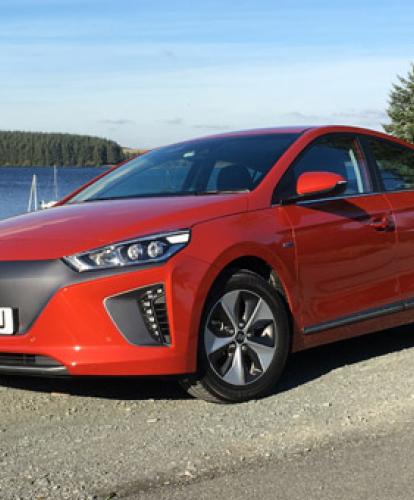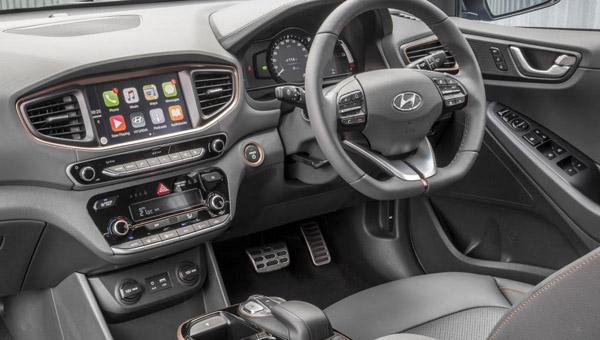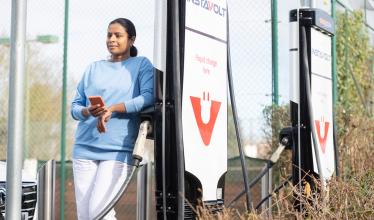You wait ages for longer range EVs and then three come along within a few months of each other. Following in the footsteps of Nissan’s Leaf 30kWh setting a new bar for EV range at the end of last year, BMW, Renault and now Hyundai have all released new electric models recently.
The only one of the trio that is completely new is Hyundai’s Ioniq Electric though, and Zapmap attended the UK launch in Liverpool to try the newcomer out.
The key facts are these:
Price – From £24,495 inc Category 1 PiCG
Motor – 88kW
Battery – 28kWh
Official range – 174 miles
Energy consumption – 11.5kWh / 100km
Charging socket – CCS
So now the primary statistics are out of the way, what does all that mean? Well the most often discussed EV attribute is likely to be range and here the Ioniq Electric scores highly. That quoted range of 174 miles (280km) is unlikely to be achievable unless you spend most of that route heading downhill.
But that’s the same for all EVs and the Hyundai will achieve a minimum of 130 miles unless you drive everywhere on the motorway and have an intense dislike for any speed under 70mph. The realistic, EV-conscious driving range available is around 150 miles without much effort, and that can be eked out a little more I reckon.
This puts the Ioniq comfortably ahead of its most obvious rival the Leaf 30kWh which quotes 155 miles and achieves around 125-130 with some careful driving. The Ioniq Electric will match this without any of the same care and consideration that it would take to get the Leaf 30kWh to that level.
There are a number of reasons behind this relatively long range – especially surprising considering the battery pack has a slightly smaller capacity than the Leaf 30kWh’s. The car is lighter, and it’s also extremely aerodynamic. The most important aspect in my mind though is the four selectable levels of brake energy regeneration.
The Leaf has D and B, and then Eco settings of the same two drive modes, so it technically has four levels of regen too However, the Ioniq’s works in the same way as the Mitsubishi Outlander PHEV’s and are switched up and down the range with paddles behind the steering wheel. It makes it easier to move between the different levels of braking strength as conditions change when you approach junctions for example, and is a significant contributor to increasing the Ioniq Electric’s range – both official and real-world.
Combined with this regen set-up is Hyundai’s drive mode selector which offers three different settings – Sport, Normal, and Eco. The Ionic Electric will feel slower than its EV rivals in anything but Sport mode, when the instant pick-up expected from an electric car is restored once a little extra power – normally held in reserve to improve efficiency – is unleashed. Other than this, Normal is fairly frugal in reality, and Eco behaves in almost no discernible manner to Normal apart from restricting auxiliary systems.
To drive, the Ioniq Electric feels pretty good. It’s not going to engage drivers particularly and errs on the side of caution in terms of handling set-up, but drivers can have fun with it when the mood takes. There’s not a lot of feedback coming through the steering wheel, but it is accurate enough to pilot it where you want to.
The rest of the car is fairly typical of Hyundai really. The styling outside is ‘normal’ rather than the Leaf and i3’s ‘different’, while the inside is even more standard barring the four button gear selector replacing a more traditional gearstick.
Equipment levels are very strong for its class with a good range of safety and driver assistance systems to help tempt drivers in. The touchscreen infotainment system isn’t at the top of its class but it isn’t far off, and includes a number of EV features. These include a Kia Soul EV style range-remaining roundel on the map, charge point navigation, and detailed information on energy consumption.
Interior space too is very good up front, and average in the rear. Leg and shoulder room in the back are fine, but head room will feel tight for anyone who’s tall. Other than that, the interior is comfortable, and load space in the boot is both good and easily accessible.
Charging cables are provided for both three-pin mains and Type 2 charging. Using a 50kW CCS Rapid charger, a 0-80 per cent charge will be completed in just over 30 minutes, home charging from a wall box covered in 4-5 hours, and charging from the mains will take around 12 hours. Launch models get a free wallbox from charging partner Pod Point.
So the Hyundai Ioniq Electric is the newest model to hit the EV market, but it goes straight towards the top of its class. Because of a very similar cost and longer range, I would pick an Ioniq Electric over a Leaf 30kWh, though the slightly smaller i3 is still the pick of the bunch if more money is available. The Ioniq Electric has the longest range of any small family car, though will lose out to the new Renault Zoe 40 supermini once that reaches dealership forecourts in terms of mainstream EV range.
It’s a very good car and will tempt more buyers into EV ownership I’m sure. That little extra range over the likes of the Leaf – only 25-30 miles in real world driving – will make a big difference to many. And the rest of the car is more than good enough to stand up to scrutiny once the headline statistic has caught buyers’ eyes.
Read a more thorough review of the Hyundai Ioniq Electric.





